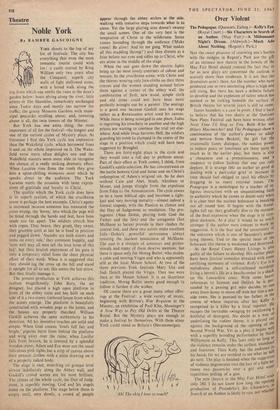Noble York
Theatre
By BAMBER GASCOIGNE But York has one extra thing, the most important of all for the festival—the longest and one of the earliest cycles of Mystery plays. As literature I find this York cycle less impressive than the Wakefield cycle, which borrowed from it and on the whole improved on it. The Wake- field verse more often delights one and the Wakefield masters seem more able to recognise the chance of a really striking dramatic effect. When Lazarus rises from the tomb they give him a spine-chilling moment° mori which he speaks direct to the audience. The York Lazarus meets the occasion with tame expres- sions of gratitude and loyalty to Christ.
The quality which the York cycle does have is its superb realism, of which the crucifixion scene is perhaps the best example. Christ's agony is increased because someone has measured the cross wrong; the 'bores,' into which the pegs will be fitted through the hands and feet, have been made too far apart. The soldiers stretch him with ropes. They heave, they grunt, they sweat, they grumble until at last he is fixed in position and pegged down. 'Asunder are both sinews and veins on every side,' they comment happily, and 'now well may all men tell the least bone of this lad'; but their brutish enjoyment of his pain is only a temporary relief from the sheer physical effort of their work. When it is suggested that they should lug the cross up the hill and stand it upright for all to see, this seems the last straw. But they finally manage it.
The present production at York achieves this realism magnificently. John Bury, the set designer, has placed a high open platform in front of the abbey ruins and has built on each side of it a two-storey timbered house from which the actors emerge. The platform is beautifully constructed with wooden pegs at the joints, and the houses are properly thatched. William Gaskill achieves the same authenticity in his direction. All his inventive touches are solid and simple. When God creates 'fowls full fair and bright,' pigeons burst from behind the platform and wing away over the ruins; when Lucifer falls from heaven, he is lowered by a splendid wooden crane; Adam and Eve wear not the usual ridiculous pink tights but a strip of canvas above their peasant clothes with a plain drawing on it of a properly naked body.
The stage is vast, stretching on ground level almost indefinitely along the Abbey wall, and Gaskill's crowd scenes are his most brilliant. The climax of the whole cycle, the Day of Judg- ment, is superbly moving. God and his angels stand on the platform. The stage below them is empty until, very slowly, a crowd of people
appear through the abbey arches at the side, walking with tentative steps towards what is to come. Yet the large' playing area doesn't swamp the small scenes. One of the very best is the temptation of Christ in the wilderness. Satan comes bounding through the audience (Wake room! Be alive! And let me gang. What makes all this madding throng?') and then dresses as a friar before our eyes and sidles up to Christ, who sits alone in the middle of the stage.
When the sun goes down the electric lights bring up the most lovely contrasts of colour and texture. In the crucifixion scene, with Christ and the thieves wearing only loin-cloths on their three crosses and the women standing around below them against a corner of the abbey wall, the combination of flesh, new wood, simple cloth and old stone could not have been more perfectly brought out by a painter. The analogy is a good one because Gaskill uses his stage rather as a Renaissance artist used his canvas.
• While Jesus is being scourged in one place, Judas is regretting his treachery in another and the high priests are waiting to continue the trial yet else- where. And while Jesus harrows Hell, the soldiers guarding his tomb lie slumped in the centre of the stage in a position which could well have been suggested by Breughel.
There are forty-eight plays in the cycle and they would take a full day to perform uncut. Part of their effect. at York comes, I think, from Gaskill's subtle selection. He has concentrated on the battle beween God and Satan and on Christ's redemption of Adam's original sin. So he does without Cain and Abel, Noah, Abraham or Moses, and jumps straight from the expulsion from Eden to the Annunciation. The cycle ceases to be a loose biblical epic and becomes a tight- knit and very moving morality—almost indeed,a formal tragedy, with the Passion as climax and the Day of Judgement as resolution. The. pro- tagonist (Alan Dobie, playing both God the Father and the Son) and the antagonist (Ian McShane as Satan) provide in their clashes the central link, and these two actors make excellent foils—Dobie's powerful seriousness always resisting the insolent bounciness, of McShane. The cast is a mixture of amateurs and profes- sionals and many of them deserve mention; but there is space only for Morag Butler, who makes a calm and moving.Virgin and who is apparently still at the local Mount School. At two of the three previous York festivals Mary ,Ure and Judi Dench, played. the Virgin. They too were then at the Mount School. It is an illustrious tradition; Morag Butler seems good enough to follow it further if she wishes.
Of course there are a great many other offer- ings at the Festival: a wide variety of music, beginning with Britten's War Requiem at the Minster, an exhibition of Paul Klee, Massinger's A New Way to Pay Old Debts at the Theatre Royal. But the Mystery plays are enough to make a festival by themselves. With them alone York could stand as Britain's Oberammergau.
`Ah! The skin I love to touch!'


































 Previous page
Previous page